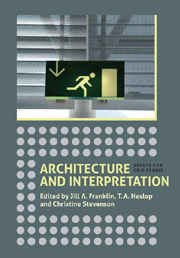Book contents
- Frontmatter
- Contents
- List of Illustrations
- Preface: In Appreciation
- List of contributors
- 1 Introduction
- Incitements to Interpret in Late Antique and Medieval Architecture
- 16 Believing is Seeing: The Natural Image in Late Antiquity
- 42 Articulation as an Expression of Function in Romanesque Architecture
- 60 Barrel-Vaulted Churches in Late Medieval Scotland
- 78 Augustinian and Other Canons' Churches in Romanesque Europe: The Significance of the Aisleless Cruciform Plan
- 99 Towers and Radiating Chapels in Romanesque Architectural Iconography
- 111 Diffusion, Imitation and Evolution: The Uncertain Origins of ‘Beakhead’ Ornament
- 128 Architecture and Pattern: The Western Façade of Lincoln Cathedral and Modernist Reference Points for its Interpretation
- Authors and Intentions
- Architecture beyond Building
- Index
78 - Augustinian and Other Canons' Churches in Romanesque Europe: The Significance of the Aisleless Cruciform Plan
from Incitements to Interpret in Late Antique and Medieval Architecture
Published online by Cambridge University Press: 05 April 2013
- Frontmatter
- Contents
- List of Illustrations
- Preface: In Appreciation
- List of contributors
- 1 Introduction
- Incitements to Interpret in Late Antique and Medieval Architecture
- 16 Believing is Seeing: The Natural Image in Late Antiquity
- 42 Articulation as an Expression of Function in Romanesque Architecture
- 60 Barrel-Vaulted Churches in Late Medieval Scotland
- 78 Augustinian and Other Canons' Churches in Romanesque Europe: The Significance of the Aisleless Cruciform Plan
- 99 Towers and Radiating Chapels in Romanesque Architectural Iconography
- 111 Diffusion, Imitation and Evolution: The Uncertain Origins of ‘Beakhead’ Ornament
- 128 Architecture and Pattern: The Western Façade of Lincoln Cathedral and Modernist Reference Points for its Interpretation
- Authors and Intentions
- Architecture beyond Building
- Index
Summary
THE IDEAS explored in this paper are based on the premise that, for a brief period of about three decades, within the reign of King Henry I (1100–35), church design for English Augustinian canons normally adhered to a particular type of plan, one that was cruciform with an unaisled nave and chancel. The premise is underpinned by evidence which is set out in more detail elsewhere. This paper interprets this evidence from, broadly speaking, a humanist point of view. The question at its heart, one which only art historians seriously address, is why artefacts, in this case canons’ churches, took the form they did. The conclusions reached differ somewhat from prevailing views, drawing new inferences from the little evidence we have.
It is suggested here that the use of the plan by Augustinian canons was partly customary but also reflected a concerted revival, corresponding to the resurgence of First Christian ideals in Europe during the period that has been called the Medieval Reformation. The assertion here is that the adoption of a distinctive plan was a carefully considered choice that Augustinians and their sponsors consistently made for a time, partly in an attempt to mark themselves out in the religious landscape. Counter-arguments that the plan is devoid of meaning and was merely a cheap, rapid and simple church-building solution are swiftly dispelled by the many large, even monumental examples of its use, while its perceived simplicity was, in practice, liturgically rather awkward and was occasionally modified accordingly.
- Type
- Chapter
- Information
- Architecture and InterpretationEssays for Eric Fernie, pp. 78 - 98Publisher: Boydell & BrewerPrint publication year: 2012



